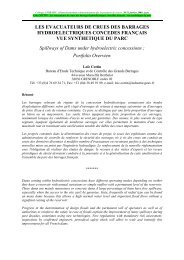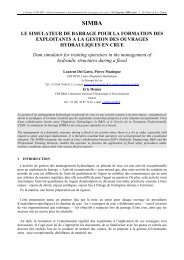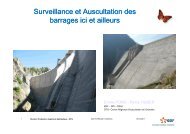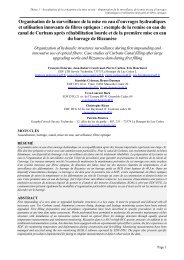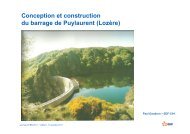Spanish Masonry Dams - Barrages en Maçonnerie en Espagne
Spanish Masonry Dams - Barrages en Maçonnerie en ... - CFBR
Spanish Masonry Dams - Barrages en Maçonnerie en ... - CFBR
- No tags were found...
You also want an ePaper? Increase the reach of your titles
YUMPU automatically turns print PDFs into web optimized ePapers that Google loves.
<strong>Spanish</strong> <strong>Masonry</strong> <strong>Dams</strong> - <strong>Barrages</strong> <strong>en</strong> <strong>Maçonnerie</strong> <strong>en</strong> <strong>Espagne</strong><br />
Diego Saldaña Arce<br />
Paris, 31th January 2012
Introduction<br />
‣ Dam construction in Spain starts at the beginning of our era, wh<strong>en</strong> the whole Iberian P<strong>en</strong>insula was<br />
already a Province of the Roman Empire<br />
‣ Since th<strong>en</strong>, dam construction has continued until today without significant pauses, with differ<strong>en</strong>t rates<br />
and objectives dep<strong>en</strong>ding on the period.<br />
‣ The first concrete gravity dam -El Regato dam- was completed in 1898 but, however, the great majority<br />
of all dams constructed before the beginning of the <strong>Spanish</strong> Civil War (1936) were masonry gravity dams<br />
‣ After the Civil War the use of<br />
masonry decreased quickly, except<br />
in the Canary Islands where it was<br />
used until the 1970s<br />
‣ Earth dams have always be<strong>en</strong><br />
quite unusual and of little<br />
importance in Spain until the<br />
second half of the 20th c<strong>en</strong>tury,<br />
except during the Roman Period.<br />
I am going to include them in this<br />
pres<strong>en</strong>tation so you can get a<br />
whole picture of <strong>Spanish</strong> dams<br />
Cornalbo dam - 21 m (1st A.D.)
Introduction<br />
‣ Dam construction in Spain starts at the beginning of our era, wh<strong>en</strong> the whole Iberian P<strong>en</strong>insula was<br />
already a Province of the Roman Empire<br />
‣ Since th<strong>en</strong>, dam construction has continued until today without significant pauses, with differ<strong>en</strong>t rates<br />
and objectives dep<strong>en</strong>ding on the period.<br />
‣ The first concrete gravity dam -El Regato dam- was completed in 1898 but, however, the great majority<br />
of all dams constructed before the beginning of the <strong>Spanish</strong> Civil War (1936) were masonry gravity dams<br />
‣ After the Civil War the use of<br />
masonry decreased quickly, except<br />
in the Canary Islands where it was<br />
used until the 1970s<br />
‣ Earth dams have always be<strong>en</strong><br />
quite unusual and of little<br />
importance in Spain until the<br />
second half of the 20th c<strong>en</strong>tury,<br />
except during the Roman Period.<br />
I am going to include them in this<br />
pres<strong>en</strong>tation so you can get a<br />
whole picture of <strong>Spanish</strong> dams<br />
El Regato dam - 20 m (1897)
Introduction<br />
‣ Dam construction in Spain starts at the beginning of our era, wh<strong>en</strong> the whole Iberian P<strong>en</strong>insula was<br />
already a Province of the Roman Empire<br />
‣ Since th<strong>en</strong>, dam construction has continued until today without significant pauses, with differ<strong>en</strong>t rates<br />
and objectives dep<strong>en</strong>ding on the period.<br />
‣ The first concrete gravity dam -El Regato dam- was completed in 1898 but, however, the great majority<br />
of all dams constructed before the beginning of the <strong>Spanish</strong> Civil War (1936) were masonry gravity dams<br />
‣ After the Civil War the use of<br />
masonry decreased quickly, except<br />
in the Canary Islands where it was<br />
used until the 1970s<br />
‣ Earth dams have always be<strong>en</strong><br />
quite unusual and of little<br />
importance in Spain until the<br />
second half of the 20th c<strong>en</strong>tury,<br />
except during the Roman Period.<br />
I am going to include them in this<br />
pres<strong>en</strong>tation so you can get a<br />
whole picture of <strong>Spanish</strong> dams<br />
Camporredondo dam - 76 m (1930)
Introduction<br />
‣ Dam construction in Spain starts at the beginning of our era, wh<strong>en</strong> the whole Iberian P<strong>en</strong>insula was<br />
already a Province of the Roman Empire<br />
‣ Since th<strong>en</strong>, dam construction has continued until today without significant pauses, with differ<strong>en</strong>t rates<br />
and objectives dep<strong>en</strong>ding on the period.<br />
‣ The first concrete gravity dam -El Regato dam- was completed in 1898 but, however, the great majority<br />
of all dams constructed before the beginning of the <strong>Spanish</strong> Civil War (1936) were masonry gravity dams<br />
‣ After the Civil War the use of<br />
masonry decreased quickly, except<br />
in the Canary Islands where it was<br />
used until the 1970s<br />
‣ Earth dams have always be<strong>en</strong><br />
quite unusual and of little<br />
importance in Spain until the<br />
second half of the 20th c<strong>en</strong>tury,<br />
except during the Roman Period.<br />
I am going to include them in this<br />
pres<strong>en</strong>tation so you can get a<br />
whole picture of <strong>Spanish</strong> dams<br />
Cueva de las Niñas dam - 32 m (1959)
Introduction<br />
‣ Dam construction in Spain starts at the beginning of our era, wh<strong>en</strong> the whole Iberian P<strong>en</strong>insula was<br />
already a Province of the Roman Empire<br />
‣ Since th<strong>en</strong>, dam construction has continued until today without significant pauses, with differ<strong>en</strong>t rates<br />
and objectives dep<strong>en</strong>ding on the period.<br />
‣ The first concrete gravity dam -El Regato dam- was completed in 1898 but, however, the great majority<br />
of all dams constructed before the beginning of the <strong>Spanish</strong> Civil War (1936) were masonry gravity dams<br />
‣ After the Civil War the use of<br />
masonry decreased quickly, except<br />
in the Canary Islands where it was<br />
used until the 1970s<br />
‣ Earth dams have always be<strong>en</strong><br />
quite unusual and of little<br />
importance in Spain until the<br />
second half of the 20th c<strong>en</strong>tury,<br />
except during the Roman Period.<br />
I am going to include them in this<br />
pres<strong>en</strong>tation so you can get a<br />
whole picture of <strong>Spanish</strong> dams<br />
Ontígola dam - 11 m (1565)
Introduction<br />
‣ In the resarch group on masonry dams from Cantabria and Burgos Universities, we have be<strong>en</strong> studying<br />
the evolution of <strong>Spanish</strong> dams for the last t<strong>en</strong> years.<br />
‣ First of all, we should clarify what the scope of our research is, or better said, What type of dams do we<br />
mean wh<strong>en</strong> we refer to masonry dams?<br />
- Until the 19th c<strong>en</strong>tury, we mean traditional masonry dams, that is to say, those dams constructed with masonry<br />
work, ashlar work and anci<strong>en</strong>t concrete<br />
- Since the beginning of the 20th c<strong>en</strong>tury, we include both traditional masonry dams as well as those in which<br />
stone blocks are used for differ<strong>en</strong>t objectives and with a very variable perc<strong>en</strong>tage<br />
‣ As a result of this research, we have established four differ<strong>en</strong>t periods in the evolution of <strong>Spanish</strong><br />
masonry dams:<br />
- Roman Period (66 dams)<br />
- Middle Ages (27 dams)<br />
- From the 16th c<strong>en</strong>tury to the middle of the 19th c<strong>en</strong>tury (48 dams)<br />
- Since the middle of the 19th c<strong>en</strong>tury (242 dams)<br />
‣ For each of these periods, we have studied the following topics: Dam Design, Materials, Outlet Works<br />
and Construction Techniques
Roman <strong>Dams</strong>
Roman dams. G<strong>en</strong>eral Aspects<br />
‣ Dam construction in Hispania begins sooner than in other Provinces, ext<strong>en</strong>ding from the first c<strong>en</strong>tury to<br />
the fall of the Roman Empire<br />
‣ We know 66 dams -two of them still in use- which include all the kinds of typologies ever used by the<br />
Romans<br />
‣ Some of these dams can be considered trials of new typologies, which would be used later in other<br />
provinces<br />
‣ With time, the cumulated experi<strong>en</strong>ce translated into choosing the best typology for each specific case<br />
PURPOSE OF ROMAN DAMS<br />
roads<br />
transfers<br />
mining<br />
others<br />
irrigation<br />
w.supply (towns)<br />
irrigation small villae<br />
water supply
Roman dams design. Typological classification<br />
‣ The typological classification that we propose for Roman dams:<br />
- Avoids m<strong>en</strong>tioning the possible int<strong>en</strong>tions of the builder, which we obviously do not know<br />
- Is based on the main resistant scheme of the constructed dam<br />
‣ So, the typologies considered are the following:<br />
earth<br />
arch<br />
earth+mas. facing<br />
gravity wall<br />
buttress dams<br />
wall+earth reinf.<br />
gravity wall+buttress reinf.
Roman dams design. Typological classification<br />
‣ The typological classification that we propose for Roman dams:<br />
- Avoids m<strong>en</strong>tioning the possible int<strong>en</strong>tions of the builder, which we obviously do not know<br />
- Is based on the main resistant scheme of the constructed dam<br />
‣ So, the typologies considered are the following:<br />
earth<br />
arch<br />
earth+mas. facing<br />
gravity wall<br />
buttress dams<br />
wall+earth reinf.<br />
gravity wall+buttress reinf.
Roman Dam Design. Gravity wall<br />
‣ The simple gravity wall was the gravity typology most oft<strong>en</strong> used, 25 dams of this type being known<br />
‣ The stability of these dams is based on the weight of a wall with a rectangular cross section<br />
‣ These dams show a very variable width and height relation (betwe<strong>en</strong> 0.4, and 2.0)<br />
‣ The gravity wall was used for both large and small dams (from 0.8 m to 34 m)
Roman Dam Design. Gravity wall<br />
‣ The simple gravity wall was the gravity typology most oft<strong>en</strong> used, 25 dams of this type being known<br />
‣ The stability of these dams is based on the weight of a wall with a rectangular cross section<br />
‣ These dams show a very variable width and height relation (betwe<strong>en</strong> 0.4, and 2.0)<br />
‣ The gravity wall was used for both large and small dams (from 0.8 m to 34 m)<br />
Moracantá dam - 2 m (2nd C<strong>en</strong>tury A.D.)
Roman Dam Design. Gravity wall<br />
‣ The simple gravity wall was the gravity typology most oft<strong>en</strong> used, 25 dams of this type being known<br />
‣ The stability of these dams is based on the weight of a wall with a rectangular cross section<br />
‣ These dams show a very variable width and height relation (betwe<strong>en</strong> 0.4, and 2.0)<br />
‣ The gravity wall was used for both large and small dams (from 0.8 m to 34 m)<br />
Almonacid de la Cuba dam - 34 m (1st C<strong>en</strong>tury A.D.)
Roman Dam Design. Gravity wall with buttress reinforcem<strong>en</strong>t downstream<br />
‣ We know 18 dams which were reinforced by Roman <strong>en</strong>gineers, with the addition of buttresses<br />
downstream<br />
‣ These buttresses were usually placed in the c<strong>en</strong>tral zone, dep<strong>en</strong>ding on their contribution to spacing<br />
and wall sl<strong>en</strong>derness<br />
‣ This typology was g<strong>en</strong>erally used in small or medium sized dams
Roman Dam Design. Gravity wall with buttress reinforcem<strong>en</strong>t downstream<br />
‣ We know 18 dams which were reinforced by Roman <strong>en</strong>gineers, with the addition of buttresses<br />
downstream<br />
‣ These buttresses were usually placed in the c<strong>en</strong>tral zone, dep<strong>en</strong>ding on their contribution to spacing<br />
and wall sl<strong>en</strong>derness<br />
‣ This typology was g<strong>en</strong>erally used in small or medium sized dams
Roman Dam Design. Gravity wall with buttress reinforcem<strong>en</strong>t downstream<br />
‣ We know 18 dams which were reinforced by Roman <strong>en</strong>gineers, with the addition of buttresses<br />
downstream<br />
‣ These buttresses were usually placed in the c<strong>en</strong>tral zone, dep<strong>en</strong>ding on their contribution to spacing<br />
and wall sl<strong>en</strong>derness<br />
‣ This typology was g<strong>en</strong>erally used in small or medium sized dams<br />
Araya dam - 4 m (2nd C<strong>en</strong>tury A.D.)
Roman Dam Design. Gravity wall with earth reinforcem<strong>en</strong>t downstream<br />
‣ Another way to reinforce the rectangular gravity wall consisted in the addtion of an earth embankm<strong>en</strong>t<br />
downstream<br />
‣ We have id<strong>en</strong>tified 5 dams of this type whose height, as in the previous type, is rather small<br />
‣ The width and height relation is smaller and less variable than in the case of a simple wall
Roman Dam Design. Buttress <strong>Dams</strong><br />
‣ The second typology considered is the buttress typology, of which only 3 dams are known<br />
‣ Width and height relation is much more reduced in this case (from 0.15 to 0.27)<br />
‣ So the buttresses contribution is indisp<strong>en</strong>sable to guarantee the stability of the sl<strong>en</strong>der wall<br />
‣ This scheme was used in medium sized dams, wich probably collapsed shortly after being built
Roman Dam Design. Buttress <strong>Dams</strong><br />
‣ The second typology considered is the buttress typology, of which only 3 dams are known<br />
‣ Width and height relation is much more reduced in this case (from 0.15 to 0.27)<br />
‣ So the buttresses contribution is indisp<strong>en</strong>sable to guarantee the stability of the sl<strong>en</strong>der wall<br />
‣ This scheme was used in medium sized dams, wich probably collapsed shortly after being built<br />
Iturranduz dam - 7 m (2nd C<strong>en</strong>tury A.D.)
Roman Dam Design. Buttress <strong>Dams</strong><br />
‣ The second typology considered is the buttress typology, of which only 3 dams are known<br />
‣ Width and height relation is much more reduced in this case (from 0.15 to 0.27)<br />
‣ So the buttresses contribution is indisp<strong>en</strong>sable to guarantee the stability of the sl<strong>en</strong>der wall<br />
‣ This scheme was used in medium sized dams, wich probably collapsed shortly after being built<br />
Iturranduz dam - 7 m (2nd C<strong>en</strong>tury A.D.)
Roman Dam Design. Buttress <strong>Dams</strong><br />
‣ The second typology considered is the buttress typology, of which only 3 dams are known<br />
‣ Width and height relation is much more reduced in this case (from 0.15 to 0.27)<br />
‣ So the buttresses contribution is indisp<strong>en</strong>sable to guarantee the stability of the sl<strong>en</strong>der wall<br />
‣ This scheme was used in medium sized dams, wich probably collapsed shortly after being built<br />
Consuegra dam - 6 m (3th-4th C<strong>en</strong>tury A.D.)
Roman Dam Design. Earth dam with upstream masonry facing<br />
‣ The third typology considered could be named “earth dam with upstream masonry facing”, 10 dams of<br />
this type being known<br />
‣ In this case there is a clear differ<strong>en</strong>ce betwe<strong>en</strong> the objectives of the masonry facing (imperviousness)<br />
and the earth embankm<strong>en</strong>t (structural)<br />
‣ In earlier times this typology was used in large dams, including up to 20.8 m high dams
Roman Dam Design. Earth dam with upstream masonry facing<br />
‣ The third typology considered could be named “earth dam with upstream masonry facing”, 10 dams of<br />
this type being known<br />
‣ In this case there is a clear differ<strong>en</strong>ce betwe<strong>en</strong> the objectives of the masonry facing (imperviousness)<br />
and the earth embankm<strong>en</strong>t (structural)<br />
‣ In earlier times this typology was used in large dams, including up to 20.8 m high dams<br />
Alcantarilla dam - 18 m (1st C<strong>en</strong>tury A.D.)
Roman Dam Design. Earth dam with upstream masonry facing<br />
‣ The third typology considered could be named “earth dam with upstream masonry facing”, 10 dams of<br />
this type being known<br />
‣ In this case there is a clear differ<strong>en</strong>ce betwe<strong>en</strong> the objectives of the masonry facing (imperviousness)<br />
and the earth embankm<strong>en</strong>t (structural)<br />
‣ In earlier times this typology was used in large dams, including up to 20.8 m high dams<br />
Proserpina dam - 21 m (1st-2nd C<strong>en</strong>tury A.D.)
Roman Dam Design. Earth dam with upstream masonry facing<br />
‣ The third typology considered could be named “earth dam with upstream masonry facing”, 10 dams of<br />
this type being known<br />
‣ In this case there is a clear differ<strong>en</strong>ce betwe<strong>en</strong> the objectives of the masonry facing (imperviousness)<br />
and the earth embankm<strong>en</strong>t (structural)<br />
‣ In earlier times this typology was used in large dams, including up to 20.8 m high dams<br />
Cornalbo dam - 21 m (1st-2nd C<strong>en</strong>tury A.D.)
Roman Dam Design. Other typologies<br />
It<br />
‣ We only know two earth dams, which in any case would have be<strong>en</strong> very scarce and difficult to id<strong>en</strong>tify<br />
nowadays<br />
‣ Arch dams were also unusual, only three dams being known, the origin and dim<strong>en</strong>sions of which have<br />
not be<strong>en</strong> clearly established<br />
Irueña dam - 7 m<br />
El Hocino dam - 18 m
Roman <strong>Dams</strong>. Materials<br />
‣ Roman builders mastered the use of construction materials, especially conglomerates and concrete.<br />
‣ Six differ<strong>en</strong>t types of masonry were used in dam construction<br />
‣ A deeper knowledge of the pot<strong>en</strong>tial of each type of masonry translated into the use of homog<strong>en</strong>eous<br />
walls for small and medium sized dams, and multilayer walls in the case of large dams
Roman <strong>Dams</strong>. Materials<br />
‣ Roman builders mastered the use of construction materials, especially conglomerates and concrete.<br />
‣ Six differ<strong>en</strong>t types of masonry were used in dam construction<br />
‣ A deeper knowledge of the pot<strong>en</strong>tial of each type of masonry translated into the use of homog<strong>en</strong>eous<br />
walls for small and medium sized dams, and multilayer walls in the case of large dams<br />
OPUS QUADRATUM
Roman <strong>Dams</strong>. Materials<br />
‣ Roman builders mastered the use of construction materials, especially conglomerates and concrete.<br />
‣ Six differ<strong>en</strong>t types of masonry were used in dam construction<br />
‣ A deeper knowledge of the pot<strong>en</strong>tial of each type of masonry translated into the use of homog<strong>en</strong>eous<br />
walls for small and medium sized dams, and multilayer walls in the case of large dams<br />
OPUS VITTATUM
Roman <strong>Dams</strong>. Materials<br />
‣ Roman builders mastered the use of construction materials, especially conglomerates and concrete.<br />
‣ Six differ<strong>en</strong>t types of masonry were used in dam construction<br />
‣ A deeper knowledge of the pot<strong>en</strong>tial of each type of masonry translated into the use of homog<strong>en</strong>eous<br />
walls for small and medium sized dams, and multilayer walls in the case of large dams<br />
OPUS INCAERTUM
Roman <strong>Dams</strong>. Materials<br />
‣ Roman builders mastered the use of construction materials, especially conglomerates and concrete.<br />
‣ Six differ<strong>en</strong>t types of masonry were used in dam construction<br />
‣ A deeper knowledge of the pot<strong>en</strong>tial of each type of masonry translated into the use of homog<strong>en</strong>eous<br />
walls for small and medium sized dams, and multilayer walls in the case of large dams<br />
OPUS CAEMENTICIUM
Roman <strong>Dams</strong>. Materials<br />
‣ Roman builders mastered the use of construction materials, especially conglomerates and concrete.<br />
‣ Six differ<strong>en</strong>t types of masonry were used in dam construction<br />
‣ A deeper knowledge of the pot<strong>en</strong>tial of each type of masonry translated into the use of homog<strong>en</strong>eous<br />
walls for small and medium sized dams, and multilayer walls in the case of large dams<br />
OPUS SIGNINUM
Roman <strong>Dams</strong>. Materials<br />
‣ Roman builders mastered the use of construction materials, especially conglomerates and concrete.<br />
‣ Six differ<strong>en</strong>t types of masonry were used in dam construction<br />
‣ A deeper knowledge of the pot<strong>en</strong>tial of each type of masonry translated into the use of homog<strong>en</strong>eous<br />
walls for small and medium sized dams, and multilayer walls in the case of large dams<br />
OPUS TESTACEUM
Roman <strong>Dams</strong>. Materials<br />
‣ Roman builders mastered the use of construction materials, especially conglomerates and concrete.<br />
‣ Six differ<strong>en</strong>t types of masonry were used in dam construction<br />
‣ A deeper knowledge of the pot<strong>en</strong>tial of each type of masonry translated into the use of homog<strong>en</strong>eous<br />
walls for small and medium sized dams, and multilayer walls in the case of large dams
Roman <strong>Dams</strong>. Materials<br />
‣ Roman builders mastered the use of construction materials, especially conglomerates and concrete.<br />
‣ Six differ<strong>en</strong>t types of masonry were used in dam construction<br />
‣ A deeper knowledge of the pot<strong>en</strong>tial of each type of masonry translated into the use of homog<strong>en</strong>eous<br />
walls for small and medium sized dams, and multilayer walls in the case of large dams
Roman <strong>Dams</strong>. Spillways and Intake works<br />
‣ Spillways in Roman dams were designed with a pragmatic approach<br />
‣ In rivers carrying much water, <strong>en</strong>gineers used thick cross sections plus larger spillways<br />
‣ In all dams over 5 m high (except for one) an intake tower was placed, which could be located<br />
either downstream or upstream, or inside the reservoir<br />
Almonacid de la Cuba dam - 34 m (1st-2nd C<strong>en</strong>tury A.D.)
Roman <strong>Dams</strong>. Spillways and Intake works<br />
‣ Spillways in Roman dams were designed with a pragmatic approach<br />
‣ In rivers carrying much water, <strong>en</strong>gineers used thick cross sections plus larger spillways<br />
‣ In all dams over 5 m high (except for one) an intake tower was placed, which could be located<br />
either downstream or upstream, or inside the reservoir<br />
Proserpina dam - 21 m (1st-2nd C<strong>en</strong>tury A.D.)
Middle Ages <strong>Dams</strong>
Middle Age <strong>Dams</strong>. G<strong>en</strong>eral Aspects<br />
‣ During the Middle Ages, the importance of projects developed in Spain decreased due to the changes<br />
in the political, social, administrative and economic structures<br />
‣ During these c<strong>en</strong>turies, irrigation was the predominant use, the industrial use of the <strong>en</strong>ergy appearing at<br />
the <strong>en</strong>d of this period.<br />
‣ We have studied the 27 most important dams of this period, which were usually diversion dams<br />
‣ The size of these dams is clearly smaller than the Roman and R<strong>en</strong>aissance dams<br />
12<br />
10<br />
8<br />
Christian<br />
Muslim<br />
6<br />
4<br />
2<br />
0<br />
0m
Middle Age <strong>Dams</strong>. Dam design<br />
‣ All Middle Ages dams known are masonry gravity dams<br />
‣ Earth dams, if they have ever existed, were of little importance and were soon destroyed or abandoned<br />
‣ The traditional Roman rectangular cross section coexists in this period with other geometries, the<br />
sections of which we have classified in four types:<br />
- Rectangular cross section<br />
- Steep sloped trapezoidal cross section<br />
- Soft sloped trapezoidal cross section<br />
- Triangular cross section<br />
Moneva dam - 5,3 m (15th C<strong>en</strong>tury A.D.)
Middle Age <strong>Dams</strong>. Dam design<br />
‣ All Middle Ages dams known are masonry gravity dams<br />
‣ Earth dams, if they have ever existed, were of little importance and were soon destroyed or abandoned<br />
‣ The traditional Roman rectangular cross section coexists in this period with other geometries, the<br />
sections of which we have classified in four types:<br />
- Rectangular cross section<br />
- Steep sloped trapezoidal cross section<br />
- Soft sloped trapezoidal cross section<br />
- Triangular cross section<br />
San Marcos dam - 11 m (14th C<strong>en</strong>tury A.D.)
Middle Age <strong>Dams</strong>. Dam design<br />
‣ All Middle Ages dams known are masonry gravity dams<br />
‣ Earth dams, if they have ever existed, were of little importance and were soon destroyed or abandoned<br />
‣ The traditional Roman rectangular cross section coexists in this period with other geometries, the<br />
sections of which we have classified in four types:<br />
- Rectangular cross section<br />
- Steep sloped trapezoidal cross section<br />
- Soft sloped trapezoidal cross section<br />
- Triangular cross section<br />
Mestalla dam - 2,5 m (10th C<strong>en</strong>tury A.D.)
Middle Age <strong>Dams</strong>. Dam design<br />
‣ All Middle Ages dams known are masonry gravity dams<br />
‣ Earth dams, if they have ever existed, were of little importance and were soon destroyed or abandoned<br />
‣ The traditional Roman rectangular cross section coexists in this period with other geometries, the<br />
sections of which we have classified in four types:<br />
- Rectangular cross section<br />
- Steep sloped trapezoidal cross section<br />
- Soft sloped trapezoidal cross section<br />
- Triangular cross section<br />
Balsar<strong>en</strong>y dam - 3 m (14th C<strong>en</strong>tury A.D.)
Design of the dams. Innovations<br />
‣ Despite the small dim<strong>en</strong>sions of these dams, two important innovations should be noted:<br />
- The adaptation of the hydraulic profile to avoid the damage to dams located in larger rivers<br />
- Improvem<strong>en</strong>t of dam foundations using wood<strong>en</strong> pile and primitive slab foundations<br />
Ferrer y Mora dam - 3 m (10th C<strong>en</strong>tury A.D.)
Design of the dams. Innovations<br />
‣ Despite the small dim<strong>en</strong>sions of these dams, two important innovations should be noted:<br />
- The adaptation of the hydraulic profile to avoid the damage to dams located in larger rivers<br />
- Improvem<strong>en</strong>t of dam foundations using wood<strong>en</strong> pile and primitive slab foundations<br />
El Vado dam - 4 m (15th C<strong>en</strong>tury A.D.)
16th c<strong>en</strong>tury to the middle of the 19th c<strong>en</strong>tury
G<strong>en</strong>eral Aspects<br />
‣ During these c<strong>en</strong>turies the rythm and size of dam construction have increased as a consequ<strong>en</strong>ce of the<br />
developm<strong>en</strong>t of irrigation and industrial uses in some areas.<br />
‣ 48 regulation dams are known, sev<strong>en</strong> of which being above 30 m high<br />
‣ During this Period there was a great improvem<strong>en</strong>t in the knowledge and application of the resistant<br />
schemes previously used, especially in the case of the arch and buttress dams<br />
DAM HEIGHT<br />
20m
G<strong>en</strong>eral Aspects<br />
‣ During these c<strong>en</strong>turies the rythm and size of dam construction have increased as a consequ<strong>en</strong>ce of the<br />
developm<strong>en</strong>t of irrigation and industrial uses in some areas.<br />
‣ 48 regulation dams are known, sev<strong>en</strong> of which being above 30 m high<br />
‣ During this Period there was a great improvem<strong>en</strong>t in the knowledge and application of the resistant<br />
schemes previously used, especially in the case of the arch and buttress dams<br />
DAM HEIGHT<br />
20m
Dam design. Gravity dams<br />
‣ The evolution from the Roman rectangular cross<br />
section to trapezoidal cross section was consolidated<br />
during this time<br />
‣ The great majority of these dams are above 20 m high,<br />
two of them being close to 50 m high<br />
Pu<strong>en</strong>tes II dam - 50 m (1791)
Dam design. Gravity dams<br />
‣ The evolution from the Roman rectangular cross<br />
section to trapezoidal cross section was consolidated<br />
during this time<br />
‣ The great majority of these dams are above 20 m high,<br />
two of them being close to 50 m high<br />
Pontón de la Oliva dam - 32 m (1957)
Dam design. Buttress dams<br />
‣ Almost 20 buttress dams are known, all of<br />
which with an industrial purpose and located in<br />
the Extremadura Region<br />
‣ Surprisingly, the most sl<strong>en</strong>der and accurate<br />
designs correspond to the highest dams<br />
Albuhera de Feria dam - 24 m (1747)
Dam design. Buttress dams<br />
‣ Almost 20 buttress dams are known, all of<br />
which with an industrial purpose and located in<br />
the Extremadura Region<br />
‣ Surprisingly, the most sl<strong>en</strong>der and accurate<br />
designs correspond to the highest dams<br />
Greña dam - 8 m (1790)
Dam design. Arch dams<br />
‣ Since the beginning of this period, there are<br />
writt<strong>en</strong> docum<strong>en</strong>ts demonstrating the reduction<br />
of the width of the dam taking advantage of the<br />
shape of the arch<br />
‣ As in buttress dams the sl<strong>en</strong>derness increases<br />
with the height of the dam<br />
Almansa dam - 23,4 m (1587)
Dam design. Arch dams<br />
‣ Since the beginning of this period, there are<br />
writt<strong>en</strong> docum<strong>en</strong>ts demonstrating the reduction<br />
of the width of the dam taking advantage of the<br />
shape of the arch<br />
‣ As in buttress dams the sl<strong>en</strong>derness increases<br />
with the height of the dam<br />
Elche dam - 23,2 m (1655)
Dam Design. Earth - Rockfill <strong>Dams</strong><br />
‣ We have id<strong>en</strong>tified four types of earth or rockfill dams, which are:<br />
- Rockfill dams with upstream masonry facing<br />
- Earth dams with upstream masonry facing<br />
- Rockfill dams with masonry diaphragm<br />
- Double masonry wall with earthfill<br />
Molino de Cabra dam - 4,5 m (
Dam Design. Earth - Rockfill <strong>Dams</strong><br />
‣ We have id<strong>en</strong>tified four types of earth or rockfill dams, which are:<br />
- Rockfill dams with upstream masonry facing<br />
- Earth dams with upstream masonry facing<br />
- Rockfill dams with masonry diaphragm<br />
- Double masonry wall with earthfill<br />
Granjilla I dam - 13,5 m (1650)
Dam Design. Earth - Rockfill <strong>Dams</strong><br />
‣ We have id<strong>en</strong>tified four types of earth or rockfill dams, which are:<br />
- Rockfill dams with upstream masonry facing<br />
- Earth dams with upstream masonry facing<br />
- Rockfill dams with masonry diaphragm<br />
- Double masonry wall with earthfill<br />
Mata de Alcántara dam - 6 m (
Dam Design. Earth - Rockfill <strong>Dams</strong><br />
‣ We have id<strong>en</strong>tified four types of earth or rockfill dams, which are:<br />
- Rockfill dams with upstream masonry facing<br />
- Earth dams with upstream masonry facing<br />
- Rockfill dams with masonry diaphragm<br />
- Double masonry wall with earthfill<br />
Gascó dam - 57 m (1788)
Spillways<br />
‣ During these c<strong>en</strong>turies, spillway design criteria did not improve substancially compared to previous<br />
periods<br />
‣ In small dams, simple lateral spillways could evacuate floods which would not be very important in any<br />
case<br />
‣ In large dams, small lateral spillways were placed, but <strong>en</strong>gineers considered the overtopping as<br />
inevitable, thus reinforcing the top of the dam and the downstream facing<br />
Barrueco de Arriba dam - 9 m (1978) (1778)
Spillways<br />
‣ During these c<strong>en</strong>turies, spillway design criteria did not improve substancially compared to previous<br />
periods<br />
‣ In small dams, simple lateral spillways could evacuate floods which would not be very important in any<br />
case<br />
‣ In large dams, small lateral spillways were placed, but <strong>en</strong>gineers considered the overtopping as<br />
inevitable, thus reinforcing the top of the dam and the downstream facing<br />
Tibi dam - 46 m (1594)
Spillways<br />
‣ During these c<strong>en</strong>turies, spillway design criteria did not improve substancially compared to previous<br />
periods<br />
‣ In small dams, simple lateral spillways could evacuate floods which would not be very important in any<br />
case<br />
‣ In large dams, small lateral spillways were placed, but <strong>en</strong>gineers considered the overtopping as<br />
inevitable, thus reinforcing the top of the dam and the downstream facing<br />
Elche dam - 23 m (1655)
Spillways<br />
‣ During these c<strong>en</strong>turies, spillway design criteria did not improve substancially compared to previous<br />
periods<br />
‣ In small dams, simple lateral spillways could evacuate floods which would not be very important in any<br />
case<br />
‣ In large dams, small lateral spillways were placed, but <strong>en</strong>gineers considered the overtopping as<br />
inevitable, thus reinforcing the top of the dam and the downstream facing<br />
Pontón de la Oliva dam - 32 m (1857)
Outlet works. Bottom outlets and intakes<br />
‣ The location of large dams in rivers with a high quantity of sedim<strong>en</strong>ts required the installation of the first<br />
large bottom outlets in the East of Spain<br />
‣ The increase in the height of the dam led to a substantial improvem<strong>en</strong>t in the design and organization<br />
of the water intakes.<br />
Elche dam - 23 m (1655)
Outlet works. Bottom outlets and intakes<br />
‣ The location of large dams in rivers with a high quantity of sedim<strong>en</strong>ts required the installation of the first<br />
large bottom outlets in the East of Spain<br />
‣ The increase in the height of the dam led to a substantial improvem<strong>en</strong>t in the design and organization<br />
of the water intakes.<br />
Tibi dam - 46 m (1594)
Outlet works. Bottom outlets and intakes<br />
‣ The location of large dams in rivers with a high quantity of sedim<strong>en</strong>ts required the installation of the first<br />
large bottom outlets in the East of Spain<br />
‣ The increase in the height of the dam led to a substantial improvem<strong>en</strong>t in the design and organization<br />
of the water intakes.<br />
Pontón de la Oliva dam - 32 m (1857)
Since the middle of the 19th c<strong>en</strong>tury
<strong>Dams</strong> since the middle of the 19th c<strong>en</strong>tury. G<strong>en</strong>eral aspects<br />
‣ The beginning of this period corresponds to the introduction of Rational Mechanics to dam design<br />
‣ The <strong>en</strong>d of this period is more difficult to determine, but we can date the beginning of the <strong>Spanish</strong><br />
Civil War (1936) as the <strong>en</strong>d of <strong>Masonry</strong> Dam Construction, although the construction of some dams<br />
ext<strong>en</strong>ded until the 1940s, or ev<strong>en</strong> later in the Canary Islands<br />
‣ During that time, substantial improvem<strong>en</strong>ts were made, relating to dam design, materials, and<br />
construction techniques as well as auxiliary facilities used in dam construction<br />
‣ We know 242 masonry dams<br />
in which one or more of the<br />
following materials were used:<br />
- Traditional masonry<br />
- Cyclopean masonry<br />
- Concreted masonry<br />
- Stoned concrete (cyclopean<br />
concrete)<br />
- Ashlar facing<br />
Buseo dam - 52 m (1915)
<strong>Dams</strong> since the middle of the 19th c<strong>en</strong>tury. G<strong>en</strong>eral aspects<br />
‣ The beginning of this period corresponds to the introduction of Rational Mechanics to dam design<br />
‣ The <strong>en</strong>d of this period is more difficult to determine, but we can date the beginning of the <strong>Spanish</strong><br />
Civil War (1936) as the <strong>en</strong>d of <strong>Masonry</strong> Dam Construction, although the construction of some dams<br />
ext<strong>en</strong>ded until the 1940s, or ev<strong>en</strong> later in the Canary Islands<br />
‣ During that time, substantial improvem<strong>en</strong>ts were made, relating to dam design, materials, and<br />
construction techniques as well as auxiliary facilities used in dam construction<br />
‣ We know 242 masonry dams<br />
in which one or more of the<br />
following materials were used:<br />
- Traditional masonry<br />
- Cyclopean masonry<br />
- Concreted masonry<br />
- Stoned concrete (cyclopean<br />
concrete)<br />
- Ashlar facing<br />
La Peña dam - 59 m (1913)
<strong>Dams</strong> since the middle of the 19th c<strong>en</strong>tury. G<strong>en</strong>eral aspects<br />
‣ The beginning of this period corresponds to the introduction of Rational Mechanics to dam design<br />
‣ The <strong>en</strong>d of this period is more difficult to determine, but we can date the beginning of the <strong>Spanish</strong><br />
Civil War (1936) as the <strong>en</strong>d of <strong>Masonry</strong> Dam Construction, although the construction of some dams<br />
ext<strong>en</strong>ded until the 1940s, or ev<strong>en</strong> later in the Canary Islands<br />
‣ During that time, substantial improvem<strong>en</strong>ts were made, relating to dam design, materials, and<br />
construction techniques as well as auxiliary facilities used in dam construction<br />
‣ We know 242 masonry dams<br />
in which one or more of the<br />
following materials were used:<br />
- Traditional masonry<br />
- Cyclopean masonry<br />
- Concreted masonry<br />
- Stoned concrete (cyclopean<br />
concrete)<br />
- Ashlar facing<br />
Conde de Guadalhorcedam - 70 m (1921)
<strong>Dams</strong> since the middle of the 19th c<strong>en</strong>tury. G<strong>en</strong>eral aspects<br />
‣ The beginning of this period corresponds to the introduction of Rational Mechanics to dam design<br />
‣ The <strong>en</strong>d of this period is more difficult to determine, but we can date the beginning of the <strong>Spanish</strong><br />
Civil War (1936) as the <strong>en</strong>d of <strong>Masonry</strong> Dam Construction, although the construction of some dams<br />
ext<strong>en</strong>ded until the 1940s, or ev<strong>en</strong> later in the Canary Islands<br />
‣ During that time, substantial improvem<strong>en</strong>ts were made, relating to dam design, materials, and<br />
construction techniques as well as auxiliary facilities used in dam construction<br />
‣ We know 242 masonry dams<br />
in which one or more of the<br />
following materials were used:<br />
- Traditional masonry<br />
- Cyclopean masonry<br />
- Concreted masonry<br />
- Stoned concrete (cyclopean<br />
concrete)<br />
- Ashlar facing<br />
Ardisa dam - 35 m (1925)
<strong>Dams</strong> since the middle of the 19th c<strong>en</strong>tury. G<strong>en</strong>eral aspects<br />
‣ The beginning of this period corresponds to the introduction of Rational Mechanics to dam design<br />
‣ The <strong>en</strong>d of this period is more difficult to determine, but we can date the beginning of the <strong>Spanish</strong><br />
Civil War (1936) as the <strong>en</strong>d of <strong>Masonry</strong> Dam Construction, although the construction of some dams<br />
ext<strong>en</strong>ded until the 1940s, or ev<strong>en</strong> later in the Canary Islands<br />
‣ During that time, substantial improvem<strong>en</strong>ts were made, relating to dam design, materials, and<br />
construction techniques as well as auxiliary facilities used in dam construction<br />
‣ We know 242 masonry dams<br />
in which one or more of the<br />
following materials were used:<br />
- Traditional masonry<br />
- Cyclopean masonry<br />
- Concreted masonry<br />
- Stoned concrete (cyclopean<br />
concrete)<br />
- Ashlar facing<br />
Pu<strong>en</strong>tes III dam - 69 m (1884)
<strong>Dams</strong> since the middle of the 19th c<strong>en</strong>tury. Dam design<br />
‣ The compreh<strong>en</strong>sive study of such a large number and variety of dams could make the analysis of the<br />
evolution of dam <strong>en</strong>gineering more difficult. So, first of all, we have id<strong>en</strong>tified two differ<strong>en</strong>t groups of<br />
dams:<br />
- Main group of dams (91 dams or 38% of the total)<br />
- Homog<strong>en</strong>eous groups of dams: <strong>Dams</strong> related to mining, power dams in the Pyr<strong>en</strong>ees, and dams in the Canary<br />
Islands<br />
‣ The difficulties related to the application of Rational Mechanics to other structural typologies explain<br />
why almost all dams of this period are gravity dams (we only know 5 buttress dams)<br />
‣ The study of the cross section and its stability has led to the classification of each dam into one of the<br />
three following types:<br />
- <strong>Dams</strong> with a “Rational type” crosss section<br />
- <strong>Dams</strong> with a “Levy type” cross section (Fr<strong>en</strong>ch influ<strong>en</strong>ce)<br />
- <strong>Dams</strong> with a “Modern type”cross section<br />
Modern type<br />
26%<br />
Rational type<br />
23%<br />
Levy type<br />
51%
<strong>Dams</strong> since the middle of the 19th c<strong>en</strong>tury. Rational type dams<br />
‣ The design of Rational type dams rely on “maximun admissible load” and “same resistance profile” criteria<br />
‣ El Villar dam was the first dam with this design, making it the most important <strong>Spanish</strong> dam of the time,<br />
and one of the most important in the world<br />
‣ The <strong>Spanish</strong> design criteria of the last third of the 19th c<strong>en</strong>tury permitted to avoid the problems suffered<br />
by other European dams of the same period<br />
El Villar dam - 51 m (1882)
<strong>Dams</strong> since the middle of the 19th c<strong>en</strong>tury. Rational type dams<br />
‣ The design of Rational type dams rely on “maximun admissible load” and “same resistance profile” criteria<br />
‣ El Villar dam was the first dam with this design, making it the most important <strong>Spanish</strong> dam of the time,<br />
and one of the most important in the world<br />
‣ The <strong>Spanish</strong> design criteria of the last third of the 19th c<strong>en</strong>tury permitted to avoid the problems suffered<br />
by other European dams of the same period<br />
Pu<strong>en</strong>tes III dam - 69 m (1884)
<strong>Dams</strong> since the middle of the 19th c<strong>en</strong>tury. Levy type dams<br />
‣ The design guidelines established by Le Rond and Levy <strong>en</strong> 1895, as a reaction to the Bouzey collapse<br />
and other incid<strong>en</strong>ts, had an influ<strong>en</strong>ce on the design of the following dams<br />
‣ These guidelines were quickly integrated by <strong>Spanish</strong> dam <strong>en</strong>gineers, despite the satisfactory<br />
performance of <strong>Spanish</strong> dams<br />
‣ So we can say without hesitation that almost all <strong>Spanish</strong> dams built in the first decades of the 20th<br />
c<strong>en</strong>tury correspond to Fr<strong>en</strong>ch inspired guidelines<br />
Buseo dam - 52 m (1902)
<strong>Dams</strong> since the middle of the 19th c<strong>en</strong>tury. Levy type dams<br />
‣ The design guidelines established by Le Rond and Levy <strong>en</strong> 1895, as a reaction to the Bouzey collapse<br />
and other incid<strong>en</strong>ts, had an influ<strong>en</strong>ce on the design of the following dams<br />
‣ These guidelines were quickly integrated by <strong>Spanish</strong> dam <strong>en</strong>gineers, despite the satisfactory<br />
performance of <strong>Spanish</strong> dams<br />
‣ So we can say without hesitation that almost all <strong>Spanish</strong> dams built in the first decades of the 20th<br />
c<strong>en</strong>tury correspond to Fr<strong>en</strong>ch inspired guidelines<br />
Cueva Foradada dam - 65 m (1929)
<strong>Dams</strong> since the middle of the 19th c<strong>en</strong>tury. Modern type dams<br />
‣ Modern cross sections are the result of improvem<strong>en</strong>ts in the knowledge of internal pressure and the<br />
performance of materials, which resulted in the reduction of the total slope<br />
‣ The majority of these dams were finished after the <strong>en</strong>d of the <strong>Spanish</strong> Civil War<br />
Jándula dam - 90 m (1931)
<strong>Dams</strong> since the middle of the 19th c<strong>en</strong>tury. Modern type dams<br />
‣ Modern cross sections are the result of improvem<strong>en</strong>ts in the knowledge of internal pressure and the<br />
performance of materials, which resulted in the reduction of the total slope<br />
‣ The majority of these dams were finished after the <strong>en</strong>d of the <strong>Spanish</strong> Civil War<br />
B<strong>en</strong>agéber dam - 110 m (1954)
<strong>Dams</strong> since the middle of the 19th c<strong>en</strong>tury. Evolution in design<br />
110<br />
Perfil Levy<br />
100<br />
Perfil Moderno<br />
Perfil Racional<br />
Transición Racional-Levy<br />
90<br />
80<br />
70<br />
60<br />
H<br />
50<br />
40<br />
30<br />
20<br />
10<br />
0<br />
1860 1870 1880 1890 1900 1910 1920 1930 1940 1950 1960<br />
Fecha
<strong>Dams</strong> since the middle of the 19th c<strong>en</strong>tury. Evolution in design<br />
110<br />
Perfil Levy<br />
100<br />
Perfil Moderno<br />
Perfil Racional<br />
Transición Racional-Levy<br />
90<br />
80<br />
70<br />
60<br />
H<br />
50<br />
40<br />
30<br />
20<br />
10<br />
0<br />
1860 1870 1880 1890 1900 1910 1920 1930 1940 1950 1960<br />
Fecha
<strong>Dams</strong> since the middle of the 19th c<strong>en</strong>tury. Evolution in design<br />
110<br />
Perfil Levy<br />
100<br />
Perfil Moderno<br />
Perfil Racional<br />
Transición Racional-Levy<br />
90<br />
80<br />
70<br />
60<br />
H<br />
50<br />
40<br />
30<br />
20<br />
10<br />
0<br />
1860 1870 1880 1890 1900 1910 1920 1930 1940 1950 1960<br />
Fecha
<strong>Dams</strong> since the middle of the 19th c<strong>en</strong>tury. Evolution in design<br />
110<br />
Perfil Levy<br />
100<br />
Perfil Moderno<br />
Perfil Racional<br />
Transición Racional-Levy<br />
90<br />
80<br />
70<br />
60<br />
H<br />
50<br />
40<br />
30<br />
20<br />
10<br />
0<br />
1860 1870 1880 1890 1900 1910 1920 1930 1940 1950 1960<br />
Fecha
<strong>Dams</strong> since the middle of the 19th c<strong>en</strong>tury. Buttress dams<br />
‣ The joint use of buttress typology and masonry was reduced, but it was so in dams of great height and<br />
importance within their hydraulic systems.<br />
‣ The collapse of the Vega de Tera dam led to the disuse of masonry in the building of buttress dams<br />
Pu<strong>en</strong>te Porto dam - 27 m (1953)
<strong>Dams</strong> since the middle of the 19th c<strong>en</strong>tury. Buttress dams<br />
‣ The joint use of buttress typology and masonry was reduced, but it was so in dams of great height and<br />
importance within their hydraulic systems.<br />
‣ The collapse of the Vega de Tera dam led to the disuse of masonry in the building of buttress dams<br />
Vega de Tera dam - 34 m (1956)
<strong>Dams</strong> since the middle of the 19th c<strong>en</strong>tury. Buttress dams<br />
‣ The joint use of buttress typology and masonry was reduced, but it was so in dams of great height and<br />
importance within their hydraulic systems.<br />
‣ The collapse of the Vega de Tera dam led to the disuse of masonry in the building of buttress dams<br />
Vega de Tera dam - 34 m (1956)
<strong>Dams</strong> since the middle of the 19th c<strong>en</strong>tury. Buttress dams<br />
‣ The joint use of buttress typology and masonry was reduced, but it was so in dams of great height and<br />
importance within their hydraulic systems.<br />
‣ The collapse of the Vega de Tera dam led to the disuse of masonry in the building of buttress dams<br />
El Espinar dam - 30 m (1959)
Merci beaucoup pour votre att<strong>en</strong>tion
‣ Initially one might have thought that the transition betwe<strong>en</strong> these three types of sections would have<br />
be<strong>en</strong> gradual as quick changes are somewhat unusual in dam <strong>en</strong>gineering.<br />
‣ If we consider the finalization date of the dams, we find that there is a time overlap betwe<strong>en</strong> the three<br />
types of sections.<br />
‣ However, if we consider the date at which the original project of each dam was writt<strong>en</strong>, we found that<br />
the overlapping betwe<strong>en</strong> the three types of profiles is very small.<br />
‣ rational profiles were used exclusively until the year 1900, wh<strong>en</strong> they were quickly replaced by the<br />
Levy profile<br />
‣ The Levy profile was quickly abandoned in 1925, wh<strong>en</strong> modern design criteria were introduced



